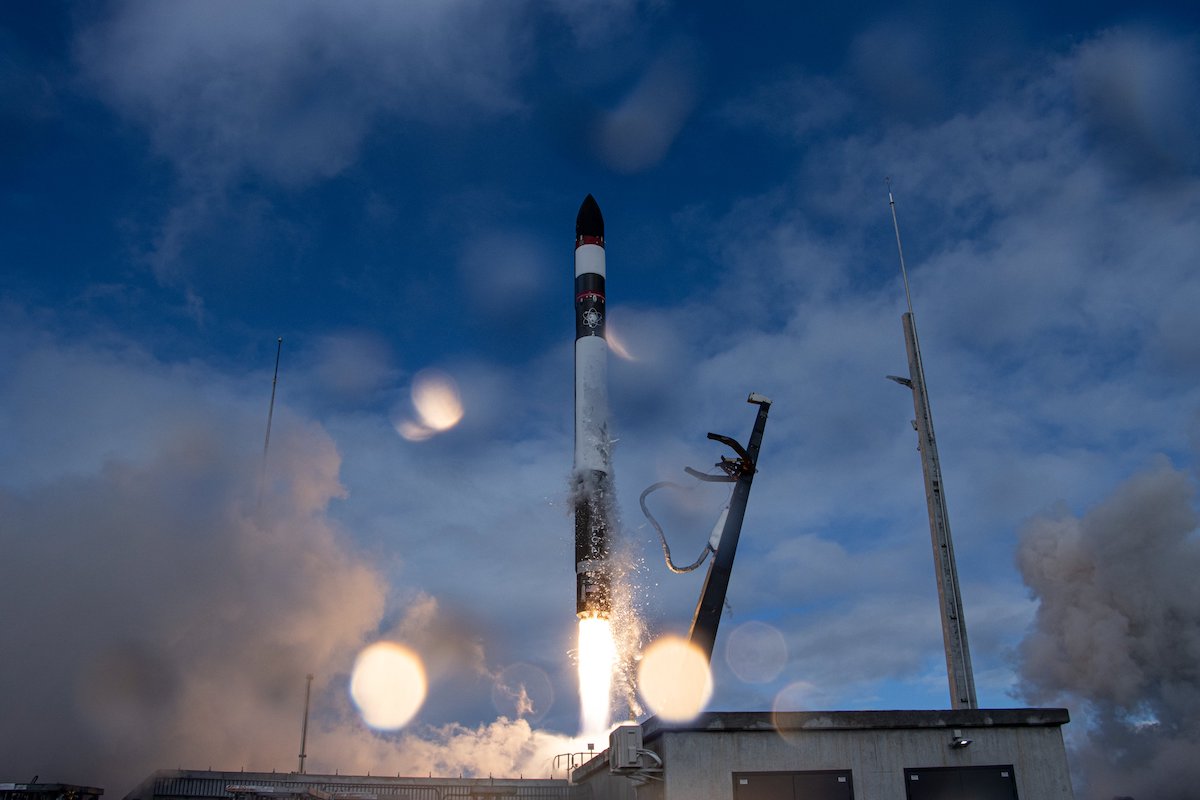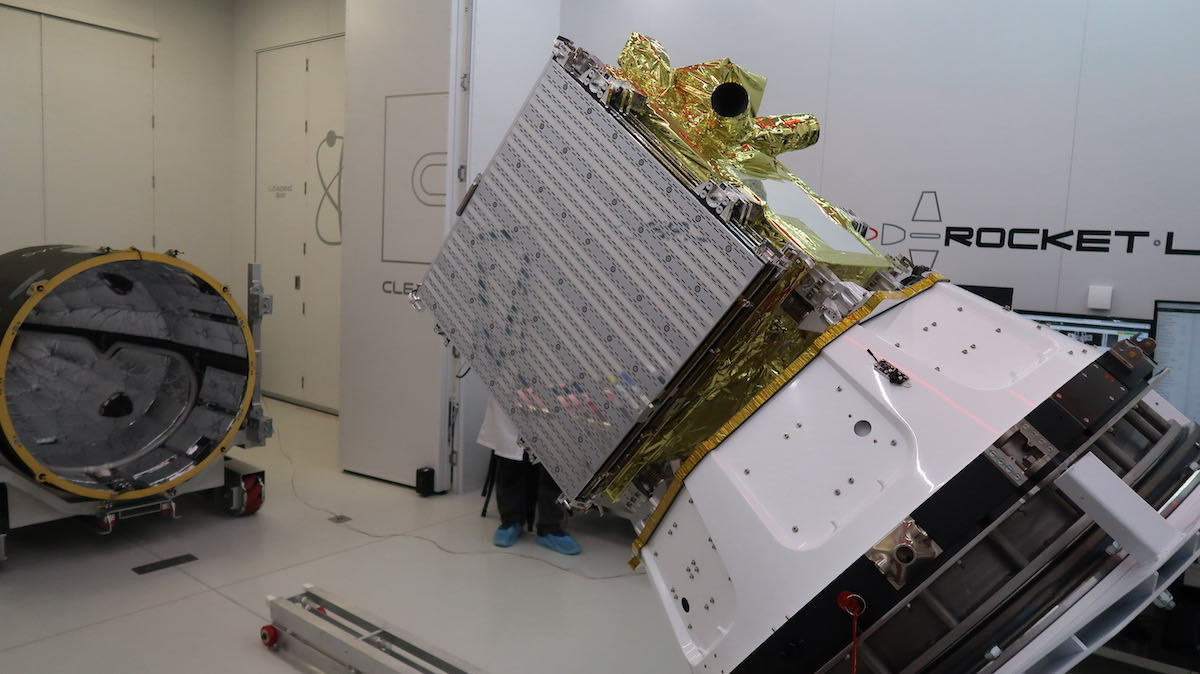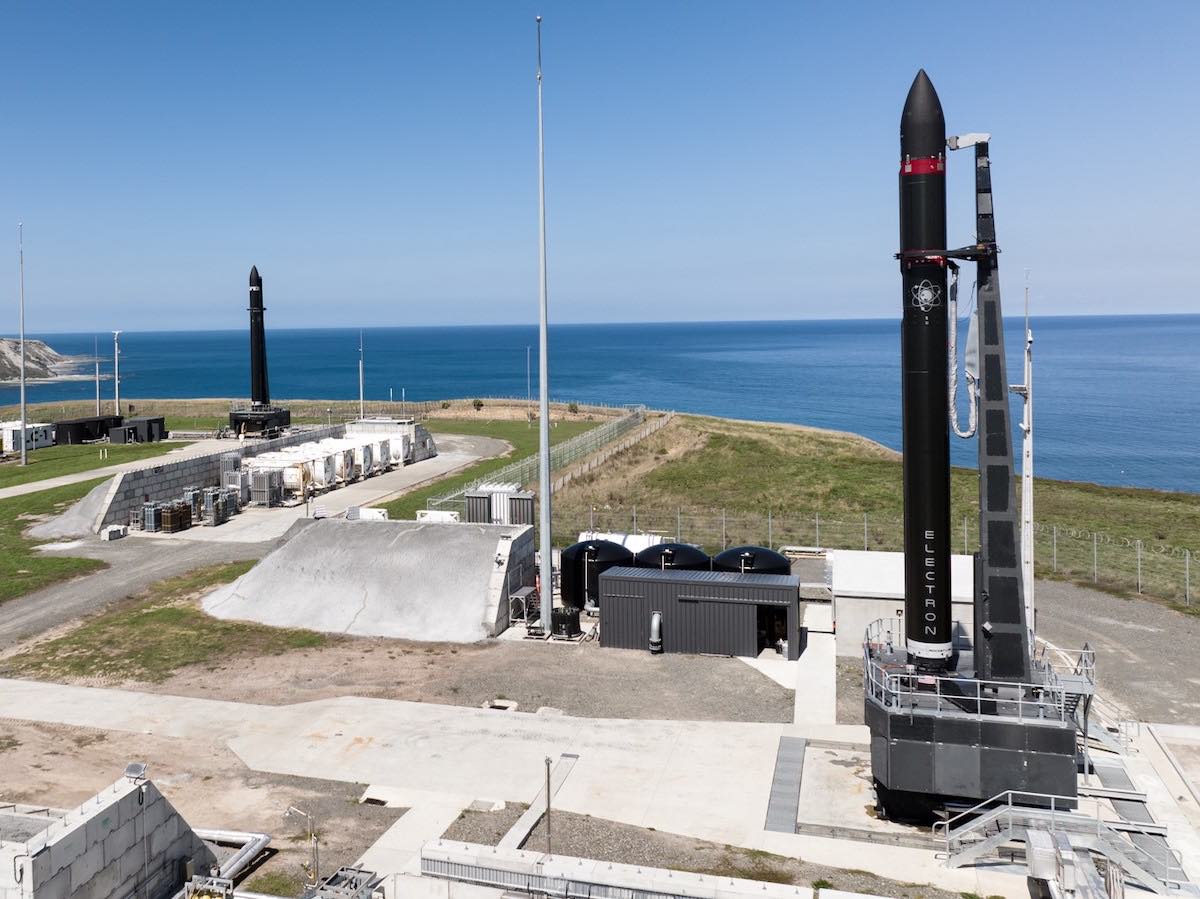
Rocket Lab brought into service a new launch pad at its privately-owned New Zealand spaceport Monday with the successful liftoff of an Electron booster and a commercial Japanese radar imaging satellite.
Burning kerosene fuel mixed with super-cold liquid oxygen, the Electron rocket roared to life with the ignition of nine Rutherford main engines. After a brief computer-run health check, the hold-down clamps opened and released the Electron rocket to climb away from Launch Complex 1B, Rocket Lab’s newest launch pad at Mahia Peninsula, home to the company’s primary operations base.
Launch occurred at 3:37:25 p.m. EST (2037 GMT) Monday, or 9:37 a.m. New Zealand time Tuesday.
The 59-foot-tall (18-meter) rocket thundered away from Mahia — situated on the east coast of the North Island — with more than 50,000 pounds of thrust. Heading south, the all-black carbon-fiber rocket cleared a cloud deck and steered through the upper atmosphere before releasing its first stage booster to fall back into the Pacific Ocean.
Rocket Lab, which is experimenting with recovering rockets for possible reuse, did not attempt to retrieve the booster on Monday’s mission. The company plans to try to catch a descending booster stage under parachute with a helicopter later this year.
The rocket’s second stage engine accelerated the mission’s sole payload — a radar remote sensing satellite owned by the Japanese company Synspective — into a preliminary orbit. Then a kick stage separated and flew halfway around the world, ignited its low-thrust engine to maneuver into a near-circular orbit, and deployed Synspective’s StriX β spacecraft.
Synspective is a Japanese startup planning a fleet of 30 commercial radar remote sensing satellites to provide high-frequency, high-resolution images worldwide. Radar imaging satellites can resolve Earth’s surface in darkness and through clouds, giving Synspective and other companies with similar constellations an all-weather observing capability.
The StriX β satellite weighs around 200 pounds, or 100 kilograms, according to Synspective. Its deployable X-band radar antenna, measuring 16 feet (5 meters) across once unfurled, can see features on Earth’s surface as small as 3 feet, or 1 meter.
The antenna and the satellite’s solar arrays were stowed for launch to fit inside the Electron rocket’s payload fairing. Rocket Lab used an enlarged payload shroud to accommodate Synspective’s satellite, which comes close to the limit of Electron’s lift capability.
The Electron kick stage released the StriX β satellite into a polar orbit with an average altitude of 351 miles (566 kilometers).
“We thank both Rocket Lab and Synspective members for their diligence and teamwork to successfully put StriX β into orbit promptly despite unforeseen circumstances and challenges due to the ongoing pandemic,” said Motoyuki Arai, Synspective’s founder and CEO. “With the successful insertion of our second SAR (synthetic aperture radar) satellite, we will be able to improve our technology for operating multiple satellites and strengthen our data services.”

Synspective, based in Tokyo, was established in 2018 and developed its satellite technology with aid from the Japanese government.
Synspective is one of several companies planning to build out constellations of radar satellites for Earth-imaging. ICEYE of Finland and California-based Capella Space have already launched multiple small satellites with sophisticated radar payloads. Umbra, another U.S. company, also recently launched its first commercial radar satellite.
Rocket Lab launched Synspective’s first satellite in December 2020. The company has two more dedicated missions for Synspective on contract for launch later this year and in 2023. One of those will carry Synspective’s first “commercial prototype” satellite, Synspective said.
“Congratulations to the team at Synspective for the successful deployment of the second satellite in their constellation,” said Peter Beck, Rocket Lab’s founder and CEO. “We are proud to continue our partnership with Synspective and to have provided fexibility around launch timing. We look forward to our upcoming missions with Synspective as they grow their SAR constellation.”
The launch was the 24th flight of a Rocket Lab Electron launch vehicle. All 23 previous Electron missions took off from Launch Complex 1A. The new Pad B site lies 383 feet (117 meters) from Launch Complex 1A.
“With two launch pads, we have doubled our capacity and reached ultimate launch flexibility,” said Shaun D’Mello, Rocket Lab’s vice president of launch. “This means when a customer needs us, we’ve got a pad ready.”
Beck said the company built the new pad to allow a higher cadence of missions. He said the new pad is “basically a replica of Pad A with some slight improvements.”
“Now we can process two rockets and launch two rockets at the same time,” he said.
Rocket Lab’s Electron vehicle is sized to carry CubeSats and small microsatellites into orbit. The company is developing a reusable medium-lift rocket, the Neutron, that officials hope will be ready to fly in 2024.
Launch Complex 1B has its own storage tanks for kerosene and liquid oxygen used by the Electron rocket. The two pads at Mahia Peninsula are independent from one another, but the facilities share a rocket integration hangar and clean rooms for processing satellites for launch.
Beck said the two pads could support two Electron launches within a day of one another.
“Our goal here would not be to launch within hours, but certainly within a day or so, there would be no problem at all,” Beck said. “But it really is a human resources issue, not an infrastructure issue.”

Rocket Lab has also built an Electron launch pad at Wallops Island, Virginia, and the company aims to launch from there later this year. The first Electron flight from the Virginia launch pad has been delayed to await certification of a new NASA range safety device, which will make its debut on the first Rocket Lab mission from Wallops.
With three launch pads soon to be in operation, Beck said Rocket Lab intends to increase its launch cadence up to a dozen missions in 2022.
“2022 is a really busy year for us,” he told Spaceflight Now in an interview last week. “Last year, we really got hampered with New Zealand government COVID restrictions.”
Rocket Lab launched six missions last year, with five successes. An upper stage engine problem prevented one of the flights from reaching orbit with two BlackSky optical Earth-imaging satellites.
“This year, we’re looking to at least double what we launched last year.”
Email the author.
Follow Stephen Clark on Twitter: @StephenClark1.
